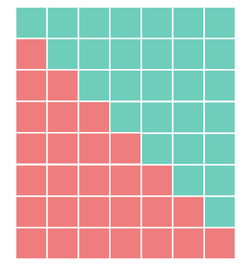거듭제곱의 합
거듭제곱의 합(power of sum)은 크게 두 가지로 나눌 수 있다: 지수가 변하는 것과 밑이 변하는 것.
지수가 변하는 거듭제곱의 합
가장 기본적인 형태는
- [math]\displaystyle{ \sum_{i=0}^n x^i = \frac{x^{n+1}-1}{x-1} }[/math]
이다. 이를 미분하여 [math]\displaystyle{ x }[/math]를 곱하면 다음을 얻는다.
- [math]\displaystyle{ \sum_{i=0}^n ix^i = \frac{x-(n+1)x^{n+1} + nx^{n+2}}{(x-1)^2}. }[/math]
비슷한 방법으로 어떤 양의 정수 [math]\displaystyle{ e_i \quad (i=0,\cdots,m) }[/math]에 대하여
- [math]\displaystyle{ \sum_{k=0}^n k^{e_0}(k-1)^{e_1}\cdots (k-m)^{e_m}x^k }[/math]
를 구할 수 있다.
급수 [math]\displaystyle{ \sum_{k \ge 0} x^k }[/math]는 [math]\displaystyle{ |x|\lt 1 }[/math]일 때 수렴하며 [math]\displaystyle{ \sum_{k \ge 0} x^k=(1-x)^{-1} }[/math]이다. 일반적으로
- [math]\displaystyle{ \left(\sum_{k \ge 0} x^k\right)^p = (1-x)^{-p} = \frac 1{(p-1)!}\sum_{n\ge 0} \frac{(n+p-1)!}{n!}x^n }[/math]
가 된다. 이와 비슷한 유한 합은
- [math]\displaystyle{ \left(\sum_{k =0}^n x^k\right)^p = \frac 1 {(p-1)!} \sum_{k=0}^{np} \frac{(n-|n-k|+p-1)!}{n-|n-k|!}x^k }[/math]
이다.
밑이 변하는 거듭제곱의 합
가장 기본적인 형태는
- [math]\displaystyle{ \sum_{i=0}^n i^p }[/math]
이다. 이는 위 경우에 비하여 계산하기가 어렵다. 고교 과정에서는 [math]\displaystyle{ p=1, 2, 3 }[/math]의 경우를 배우는데, 이항정리를 이용하여 귀납적으로 이끌어낸다. [math]\displaystyle{ \sum_{i=0}^n i^p }[/math]를 만들기 위하여 [math]\displaystyle{ (x+1)^{p+1} - x^{p+1} = \sum_{j=0}^{p} \binom{p+1}{j}x^j }[/math]를 이용한다. 이 식을 [math]\displaystyle{ i=0 }[/math]에서부터 [math]\displaystyle{ i=n }[/math]까지 더하면
- [math]\displaystyle{ \sum_{i=0}^n \left((i+1)^{p+1} - i^{p+1}\right)=(n+1)^{p+1} = \sum_{i=0}^n \sum_{j=0}^{p} \binom{p+1}{j}i^j = \sum_{j=0}^{p} \binom{p+1}{j} \sum_{i=0}^n i^j }[/math]
이다. 이를
- [math]\displaystyle{ (n+1)^{p+1}-\sum_{j=0}^{p-1}\binom{p+1}{j}\sum_{i=0}^n i^j=\binom{p+1}{p}\sum_{i=0}^n i^p }[/math]
- [math]\displaystyle{ \sum_{i=0}^n i^p = \frac{(n+1)^{p+1}}{p+1} - \frac 1 {p+1} \sum_{j=0}^{p-1}\binom{p+1}{j}\sum_{i=0}^n i^j }[/math]
로 정리하면 원하는 식을 얻는다.
베르누이 수를 이용하면 하나의 식으로 위의 합을 나타낼 수 있다. 오일러-매클로린 공식을 이용하여
- [math]\displaystyle{ \sum_{k=1}^n f(k) = \int_1 ^n f(x)\mathrm dx + \frac{1}{2}(f(1)+f(n)) + \sum_{k=1}^\infty \frac{B_k}{k!}\left(f^{(k-1)}(b) - f^{(k-1)}(a)\right) }[/math]
에서 [math]\displaystyle{ f(k) = k^p }[/math]로 두면,
- [math]\displaystyle{ \sum_{k=1}^n k^p = n^p + \sum_{k=0}^p \frac{B_k p!}{k! (p-k+1)!}n^{p-k+1} = \sum_{k=1}^{p+1} \frac{(-1)^{p-k+1}B_{p-k+1} p!}{k! (p-k+1)!}n^k }[/math]
이 식에서 계수들의 합이 1이라는 것을 쉽게 알 수 있다.
- [math]\displaystyle{ \sum_{k=1}^{p+1} \frac{(-1)^{p-k+1}B_{p-k+1} p!}{k! (p-k+1)!} = 1 }[/math]
또한 두 개의 파라미터로 변하는 급수로도 나타낼 수 있다.
- [math]\displaystyle{ \sum_{i=0}^n k^p = \sum_{i=1}^p \sum_{j=0}^{i-1} (-1)^j (i-j)^p \binom{n+p-i+1}{n-i} \binom{p+1}{j} }[/math]
공식
- [math]\displaystyle{ \sum_{k=0}^n k=\frac 1 2 n(n+1) }[/math]
- [math]\displaystyle{ \sum_{k=0}^n k^2=\frac 1 6 n(n+1)(2n+1) }[/math]
- [math]\displaystyle{ \sum_{k=0}^n k^3=\frac 1 4 n^2 (n+1)^2 }[/math]
- [math]\displaystyle{ \sum_{k=0}^n k^4=\frac 1 {30} n (n+1)(2n+1)(3n^2+3n-1) }[/math]
- [math]\displaystyle{ \sum_{k=0}^n k^5=\frac 1 {12} n^2 (n+1)^2 (2n^2 + 2n-1) }[/math]
- [math]\displaystyle{ \sum_{k=0}^n k^6=\frac 1 {42} n(n+1)(2n+1)(3n^4 + 6n^3 - 3n + 1) }[/math]
- [math]\displaystyle{ \sum_{k=0}^n k^7=\frac 1 {24} n^2 (n+1)^2 (3n^4 + 6n^3 - n^2 - 4n + 2) }[/math]
- [math]\displaystyle{ \sum_{k=0}^n k^8=\frac 1 {90} n(n+1)(2n+1)(5n^6 + 15n^5 + 5n^4 - 15n^3 - n^2 + 9n - 3) }[/math]
- [math]\displaystyle{ \sum_{k=0}^n k^9=\frac 1 {20} n^2(n+1)^2 (n^2+n-1)(2n^4 + 4n^3 - n^2 - 3n + 3) }[/math]
- [math]\displaystyle{ \sum_{k=0}^n k^{10}=\frac 1{66} n(n+1)(2n+1)(n^2+n-1)(3n^6 + 9n^5 + 2n^4 - 11n^3 + 3n^2 + 10n -5) }[/math]
1부터의 연속한 자연수의 합
특히 연속한 자연수의 합은 여러 가지 방법으로 구할 수 있다. 가장 알기 쉬운 방법으로는, 소문으로 들려오는 가우스가 어렸을 때 썼다는 방법이 있다. {| style="text-align: right;" align="center" |- | || 1 || + || 2 || + || … || + || (n-1) || + || n |- | +) || n || + || (n-1) || + || … || + || 2 || + || 1 |- | style="border-top: 1px solid black;" colspan="10" | |- | || (n+1) || + || (n+1) || + || … || + || (n+1) || + || (n+1) || [math]\displaystyle{ \quad n }[/math]-개 |}
위에서 [math]\displaystyle{ 2\sum_{k=1}^n = n(n+1), \quad \sum_{k=1}^n = \frac 1 2 n(n+1) }[/math]임을 알 수 있다.
니코마코스의 정리
세제곱의 합 공식
- [math]\displaystyle{ \sum_{k=1}^n k^3 = \frac 1 4 n^2 (n+1)^2 }[/math]
을 보면, 누구나 자연수의 합 공식의 제곱으로 나타남을 알 수 있을 것이다.
- [math]\displaystyle{ \sum_{k=1}^n k^3 = \left(\sum_{k=1}^n k\right)^2 }[/math]
이를 니코마코스의 정리(Nicomachus's theorem)라고 한다.
참고
결합기하학
결합기하학(incidence geometry)은 결합구조를 연구하는 학문이다. 해석기하학과 달리 점, 선, 그리고 그 결합만을 생각한다.
결합구조
[math]\displaystyle{ \mathscr P }[/math], [math]\displaystyle{ \mathscr L }[/math]([math]\displaystyle{ \mathscr P \cap \mathscr L = \emptyset }[/math]) 와 [math]\displaystyle{ \mathscr I\subseteq \mathscr P \times \mathscr L }[/math]가 집합일 때, [math]\displaystyle{ \sigma = (\mathscr P, \mathscr L, \mathscr I) }[/math]을 결합구조(incidence structure), 또는 기하학적 구조(geometric structure)라 한다. 만약 [math]\displaystyle{ \mathscr P }[/math]와 [math]\displaystyle{ \mathscr L }[/math]이 유한이면, [math]\displaystyle{ \sigma }[/math]를 유한결합구조라 한다. 여기서 [math]\displaystyle{ \mathscr P }[/math]는 점들의 집합이고, [math]\displaystyle{ \mathscr L }[/math]은 선[1]들의 집합이다. [math]\displaystyle{ \mathscr P }[/math]와 [math]\displaystyle{ \mathscr L }[/math]의 교집합이 공이라는 것은, 점과 선을 같은 것으로 보지 않겠다는 말이다.
주어진 점 [math]\displaystyle{ p, q\in\mathscr P }[/math]에 대하여, [math]\displaystyle{ \exists L \in \mathscr L \text{ s.t. } (p,L),(q,L)\in \mathscr I }[/math]이면 [math]\displaystyle{ p }[/math]와 [math]\displaystyle{ q }[/math]는 jointed라 하고, 만약 위를 만족하는 선 [math]\displaystyle{ L }[/math]이 단 하나 존재하면 [math]\displaystyle{ L }[/math]은 [math]\displaystyle{ p }[/math]와 [math]\displaystyle{ q }[/math]에 의하여 결정된다고 한다(선 [math]\displaystyle{ L }[/math]을 [math]\displaystyle{ p }[/math]와 [math]\displaystyle{ q }[/math]의 join이라 하고 [math]\displaystyle{ pq:=L }[/math]로 쓴다.) 비슷하게, given [math]\displaystyle{ L, M\in \mathscr L }[/math], if [math]\displaystyle{ \exists p \in \mathscr P \text{ s.t. } (p,L),(p,M)\in \mathscr I }[/math], we say [math]\displaystyle{ L }[/math] and [math]\displaystyle{ M }[/math] meet, and we say [math]\displaystyle{ p }[/math] is decided by [math]\displaystyle{ L }[/math] and [math]\displaystyle{ M }[/math] if there is only one point [math]\displaystyle{ p }[/math](we call it the intersection [math]\displaystyle{ p:=L\cap M }[/math].) And also denote [math]\displaystyle{ [p(\in\mathscr P)\in L (\in \mathscr L)] := [(p, L) \in \mathscr I] }[/math] and omit [math]\displaystyle{ \mathscr I }[/math].
평면
We shall call incidence structures [math]\displaystyle{ \pi=(\mathscr P , \mathscr I) }[/math] satisfying following axioms planes:
- [math]\displaystyle{ \forall p, q \in\mathscr P \exists ! L \in \mathscr L \text{ s.t. }p, q\in L, }[/math]
- [math]\displaystyle{ \forall L\in\mathscr L \exists p, q\in\mathscr P (p \ne q) \text{ s.t. } p, q \in L. }[/math]
아핀 평면
We call incidence structures satisfying following axioms affine planes:
- [math]\displaystyle{ \exists L \in \mathscr L, }[/math]
- [math]\displaystyle{ \forall L \in \mathscr L \exists p, q\in \mathscr P (p \ne q) \text{ s.t. }p,q\in L, }[/math]
- [math]\displaystyle{ \forall L \in \mathscr L \exists r\in\mathscr P \text{ s.t. }r \notin L, }[/math]
- [math]\displaystyle{ \forall p,q \in \mathscr P (p\ne q)\exists ! L=pq\in \mathscr L, }[/math]
- [math]\displaystyle{ \forall L \in \mathscr L \forall p (\notin L) \in \mathscr P \exists ! M \in \mathscr L \text{ s.t. } p \in M \wedge L \| M. }[/math] ([math]\displaystyle{ L \| M }[/math] means [math]\displaystyle{ \not \exists L \cap M }[/math].)
And every affine plane is a plane.
실-아핀 평면
We call incidence structures [math]\displaystyle{ \alpha_\mathbb R }[/math] satisfying following axioms real affine planes:
- [math]\displaystyle{ \mathscr P \subseteq \mathbb R^2, }[/math]
- [math]\displaystyle{ L(\in \mathscr L) = \{(x,y)|ax+by+c=0 \wedge a, b, c\in\mathbb R \wedge \neg(a=0\wedge b=0) \}, }[/math]
- [math]\displaystyle{ (x_0 , y_0) \in \{ (x,y)|ax+by+c = 0\} \Longleftrightarrow ax_0 + by_0 + c = 0. }[/math]
And every real affine plane is an affine plane.
사영 평면
뉴턴의 운동 법칙
뉴턴의 운동 법칙(Newton's laws of motion)은 아이작 뉴턴에 의해 정립된 세 가지 물리 법칙이다.
역사
제1 법칙: 관성의 법칙
외력이 없을 때 어떤 물체의 질량중심은 일정한 속도 (또는 운동량)을 가지고 운동한다.
관성의 법칙을 만족하는 기준틀(좌표계)를 관성기준틀(관성좌표계, 관성계)라 부르고, 즉 이는 등속도 운동을 하는 기준틀을 말한다.

